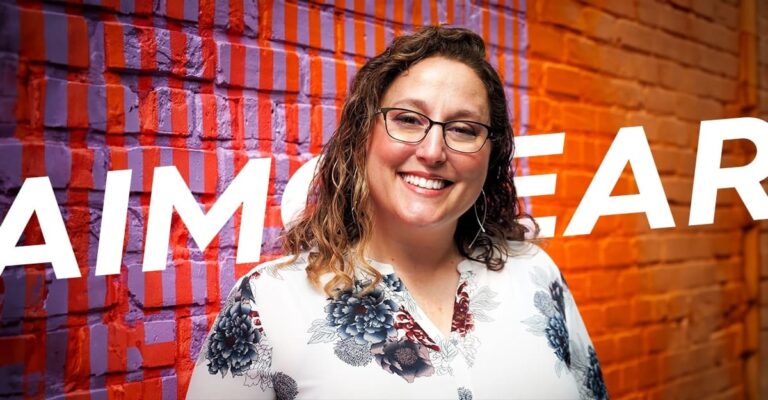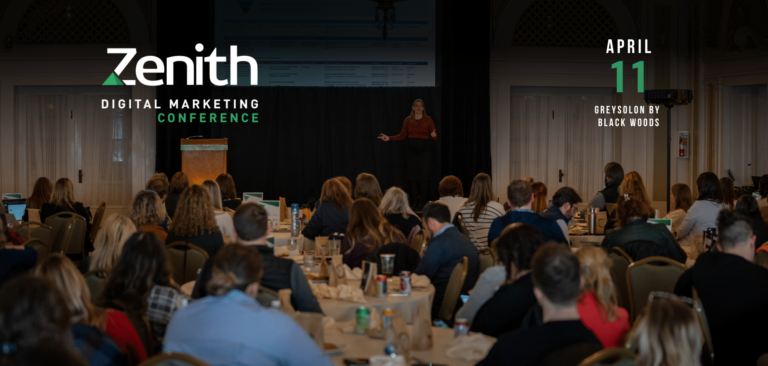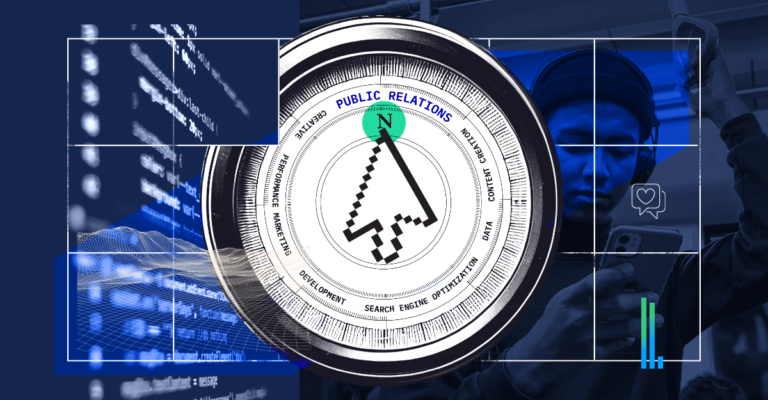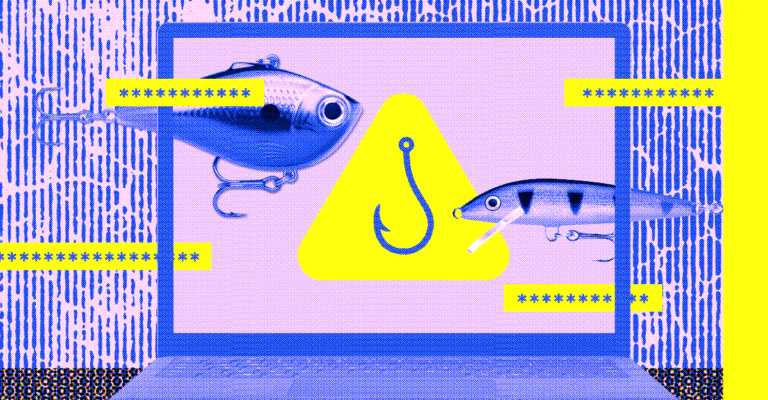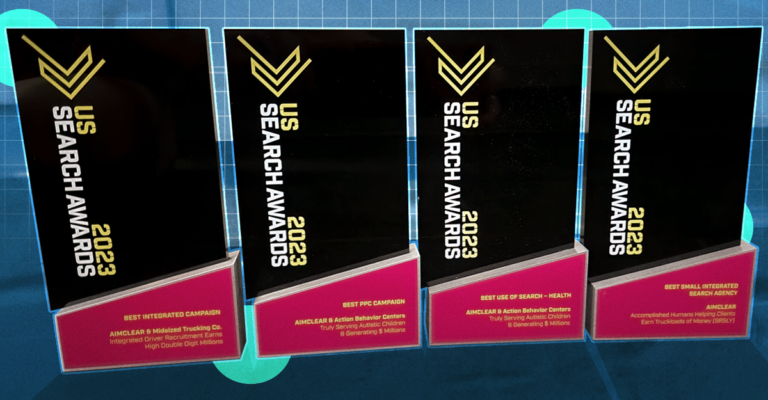This is the final in AIMCLEAR‘s 3-part series covering B2B Marketing. Check out Part 1Â and Part 2Â if you missed those.
Stop trying to marry your customer before you’ve even gone on a date.
As advertisers, if our objective is lead generation, we need to force ourselves to think beyond the obvious tactics. Turning on a traffic campaign that targets users with a website form field makes sense, but this recipe breaks down when you’re selling a $10,000 piece of equipment or an enterprise piece of software. It won’t work that quickly, especially if they’ve never heard of you. Start by introducing yourself, tell them who you are and what makes you interesting.
This is the awareness phase, where generating demand goes hand in hand with our end goal of lead generation. If the user decides they like what you’re saying, then move on to the consideration phase. You can use multiple tools to generate that demand: webinar sign-ups, eBooks, blog content, testimonial and product videos, etc.Â
Last point regarding channels: Make sure you’re focusing on a full-funnel approach and don’t be afraid to get creative with your advertising mix.
For example, LinkedIn is great for finding new users but consider retargeting them on Facebook & Instagram after they’ve visited your site. Daisy-chain these channels together so you’re not spending all your money in one place.
The B2B journey looks more like A-to-Z and less like A-to-B. The more you understand the customer journey, the less likely the complexity will frustrate you.
What is an Effective Nurture Strategy?
Once the lead is in your pipeline, it’s critical to have an effective nurture strategy.Â
As visitors in your target audience gain exposure to your brand, they may engage with a social post, visit your website, find themselves at a content filled landing page. After that – silence! – failing to become a customer.
This work turning them into a lead doesn’t have to go to waste! By creating a lead nurture strategy, you can continue to engage with prospects and provide content to move them closer to becoming a customer.
Here are 4 easy steps to help you get started with your first nurture campaign:
1. Define the audience segment.
- Demographics – Who are they? Some examples might include age, gender, marital status, household income, or education level.
- Behavior patterns – What do they enjoy doing? Shopping habits, hobbies, interest, etc.
- Challenges – What challenges do they face throughout the buying process?Â
- Motivations/Goals– What is motivating them to make a purchase? What additional value does your brand offer them in comparison to the competitor?
2. Offer value first, sales pitch later.
Do this by understanding the points in the buyer’s journey, and creating content for each unique stage:
- Awareness Stage – This is when customers become aware of a problem or opportunity. Frame their problem in a way that your brand can fill and meet their need for a solution. At this stage you want to offer educational content that helps your buyer identify the problem/opportunity your brand solves. Examples include:
- Videos
- Blog posts
- Social posts
- Infographics
- Basic quizzes
- Consideration Stage – Customers have a clearly defined problem or opportunity are committed to researching and understanding all of the available solutions. Create content that identifies a solution to their problem. At this stage, your lead has identified their problem or goal and has decided to take action. The assets you offer at this stage identify your solution to their problem, and include higher-level educational assets such as:
- Newsletters
- Inbound marketing
- Ebook
- Webinars
- Case studies
- Decision Stage – After compiling the list of solutions, the customer decides which solution is the best fit and ultimately, makes the final purchase decision. This is the end of the race. At this point content is like the cheerleader on the sideline in a game, of guiding leads through the buyer’s journey conclusion. This content should be the last little bit of encouragement to get your lead across the buying process finish line, and can include:
- Demos
- Pricing pages
- Free trials
3. Set objectives.Â
There are two types of goals that should be defined before launching the campaign:
- Quantitative goal(s) – A goal with a numerical value that’s easy to track and will define your progress throughout the campaign period.
- Qualitative goal(s) – A goal focused on soft skills (communication, adapting to change, etc.). These goals will be measured by observation and when creating a qualitative goal consider the behaviors that will lead to successful performance.Â
4. Evaluate & Optimize, the last step.
After developing goals, identifying your audience, and customizing content, your last step is to evaluate and optimize your campaign. Making sure your nurture campaign resonates with your audience at every stage is essential to engage or re-engage with them throughout the sales process.
- Identify optimizing opportunities within the campaign such as budget, bids, etc.
- If the campaign is not meeting your initial goals, identify which stage of the buying process is not working and adjust accordingly based on campaign results.
- Set up email workflows that will follow the customer through the buying process with curated messages for each stage of the buying process.
Email Marketing: Nurture Fundamentals
Email marketing: Personalization is key!
Did you know that the first email marketing blast was sent in 1978 and it actually resulted in $13 million in sales?
Crazy!
As years have passed, the email marketing world has become more and more diluted as the amount of emails being sent has increased.
So how do you stand out? Personalization – data shows that personalized email messages can improve click-through rates by 8x. Key tactics for personalizing your email campaigns include:
- Ask the right questions – Ask customers their reasons for visiting, becoming a user, etc.
- Build customer personas – An alternative to asking individual questions, you can build customer personas based on a mix of attributes and actions the visitors take while engaging with your brand.
- Make use of location and time data – It’s not a secret that certain times of day generate more leads than others. However, it’s not likely that all of your customers will be in one location or respond to emails at the same time, so using data to segment and send emails at optimal times will have the most impact and boost CTR and conversion rates.
- Set up automated behavioral-trigger emails – Behavior-triggered emails are real-time actions related to how your customers are using your product. Historically, these behavior-triggered emails have a higher open rate in comparison to traditional emails. Trigger emails, although personal, are easily automated and can be sent to encourage multiple actions: up-selling, cross-selling, welcome, re-engagement, etc.
- Personalize your brand -Â Soften the edges of big business and add a level of human connection. A simple example – signing emails using a signature of a real employee rather than just the company’s name.
- Personalize landing pages to match personalized emails - Not only should your email and lading pages have a consistent look and copy, they both should have the same personalized call to action for the customer. A unified experience will make them more likely to convert as you are showing them personalized content based on data.
A note about email, privacy and GDPR
GDPR – the General Data Protection Regulation applies wherever you process “personal data.” This means if you can identify an individual, either directly or indirectly, it will apply.
GDPR takes CAN-SPAM compliance further, applying to businesses with customers/customer data from EU citizens; however, many businesses find GDPR compliance applied to all customers is an easier path than segmenting out the customer base and applying different standards to each.Â
Disclaimer: We are not lawyers, and none of this should be taken as legal advice. Please consult an attorney for direction on your specific situation.
Here are some other top-line items to note about GDPR compliance:
- Document your legal basis for processing the information you are requesting. You must tell people what you are doing with the information.
- Consent needs to be freely given, and you need to make sure you can make certain that the information is available to the person consenting, i.e. your privacy statement.
- Consent must specifically cover the controller’s name, the purposes of the process and the types of processing activity.
- You can’t make opt-in required.Â
- You must make it easy for people to withdraw consent at any time they choose.
- You may only send individuals emails if they have specifically consented, or if they bought a similar product from you in the past and didn’t opt out from marketing messages when you gave them the chance.
- IMPORTANT: An opt-out message or unsubscribe option must be present in the message.
- You can email or text any corporate body, however it is good practice to keep a “do not email or text” list of any business that object or opt out and screen any new marketing lists against it.
Content Marketing: Nurture Fundamentals
Content marketing is defined as strategic marketing focused on creating and distributing valuable, relevant, consistent content to include profitable actions by business for business.
- Content has to be useful above all else: This is the #1 rule.
- Content should be entertaining to the reader: Define your audience using different personas and apply your content individually to each persona.
- Develop new content consistently: What are your customers talking about online? One of the best ways to generate new content is to answer that question.
- Experiment with new content consistently: Don’t get lazy! Instead of allocating an entire budget to one idea, experiment using current campaigns and only push a fraction of traffic towards new content. Creative testing allows you to “audition” your topics in front of potential buyers to see if it will do well, instead of producing tons of content with little return.
Webinars – a great way to obtain leads or a waste of time?
GoToWebinar analyzed data from more than 350,000 webinars within a year timespan and found that 73% of B2B sales/marketing leaders say webinars are the best way to obtain quality leads. If that’s not a compelling enough reason, consider that 61% of companies hosting webinars are B2B. Here’s a few quick tips to help you get started!
- Promote early and often – Start promoting content 2-4 weeks out from the event date and increase the cadence one week from the date of the event.
- Use email marketing as well as social channels – Maximize your emails by sending them at optimal times to customer lists that would be the most likely to attend. In addition, post the sign up link in other education materials like blog posts or whitepapers.
- Partnership promotion – Leverage partners to help promote (or even co-host) the webinar.
- Schedule with your audience in mind – Decide which day of the week is the most accessible for your audience. Historical data shows that Thursdays have been the best day to present a webinar (followed by Wednesday, then Tuesday).
- The longer, the better – Contrary to strategies for other marketing channels, longer webinars tend to out perform shorter ones. Though consumer attention spans are dwindling (and believed to be only 8 seconds long), the average webinar attendance time is 61 minutes! Take advantage of having the audience’s attention for that long and make a positive impression through high-value content.
- Engage – One of the benefits of having a live event is the opportunity to directly engage with your audience through polls, surveys, and Q&A. Always save time at the end of the event to take time to address audience concerns and address the audience throughout via polls and surveys. Pro-tip: The surveys, polls and Q&A make for excellent, additional, content marketing assets!
- Offer a recording and follow up – This gives you the recording to use as a piece of evergreen content, while also offering it as a free takeaway for attendees. Be sure to follow up with everyone who attended, as well as with anyone that watches the recording. This might mean directly reaching out to schedule a demo or call, or it could mean sending out a short survey about the information presented.
Lead gen is one of the most powerful weapons in a B2B marketing arsenal. Properly nurturing leads through education about your brand, products and services takes intention, awareness of the where a lead is in the buyer’s journey, and personalized content to address each one uniquely. Solid media and content marketing campaigns combined with an agile, personalized and behavior-based trigger email campaign will set you up for conversion success! AIMCLEAR specializes in 360 degree, integrated campaigns to deliver your customers – reach out if we can help you on your B2B marketing journey!
We wrapped up all the information and resources covered in our 3-part series into a complete guide that will be available for download. Grab your copy now!




